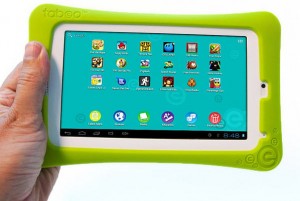By
ETCentricJanuary 22, 2013
In what may indicate a shift in print to digital pricing patterns, Cosmopolitan readers will now have to pay $19.99 for a digital subscription to the magazine on iPads. The cost of a year’s subscription for the print edition is just $10. In both the book and newspaper industries, print versions are usually still more expensive than digital ones. Continue reading Digital Magazine Prices Surpass Cost of Print Subscriptions
By
George GerbaJanuary 10, 2013
Adonit introduced the new Jot Touch, a pressure sensitive stylus that uses Bluetooth 4.0 to add pressure sensitivity to enabled programs on iPads. The battery lasts up to one month with normal use and two shortcut buttons let you adjust tools quickly. Palm rejection makes it easy to concentrate on the image and not worry about where your hands are placed. Continue reading CES 2013: iPad Meets Pressure Sensitive Jot Touch Stylus
By
ETCentricJanuary 6, 2013
Apple and Samsung continue to dominate the U.S. smartphone market, according to a new report from Tavis McCourt, technology analyst for financial services firm Raymond James. While iPhone retention remains roughly 86 percent, Samsung is consolidating the Android space domestically as it has already successfully achieved in much of the European market. Continue reading Apple and Samsung Tighten Control of U.S. Smartphone Market
By
Dennis KubaJanuary 4, 2013
With entertainment spending growing to $18.7 billion according to IHS Screen Digest, the entertainment industry is reaping the rewards of offering consumers more choice and options in how they consume content. TV Everywhere’s multi-channel, multi-device approach is finally complementing rather than cannibalizing. The year saw strong growth in Blu-ray discs. UltraViolet’s 7 million households and 8,500 titles now position the format to grow significantly in 2013. Video streaming or SVOD tripled in the first three quarters of the year to an estimated $1.7 billion. And studios continue to experiment with their windowing strategies for electronic sell-through. In this environment, the CE industry continues to respond and innovate. Continue reading CES 2013: Entertainment Trends Drive New Technologies
By
David TobiaDecember 14, 2012
During the TV of Tomorrow conference in New York, industry executives discussed how tablets, particularly the iPad, could be the future of television. Tablets and iPads have turned into the second screen for television viewing, and served as the focus of many of the talks at the conference. The second screen trend is both promising and troubling for television execs, as it presents new opportunities while also taking eyes away from advertisements.
People spend 22 minutes on second screens during a traditional 30-minute show, and 38 minutes during a 60-minute show, according to TVPlus co-founder Randy Shiozaki.
Dijit CEO Jeremy Toeman points out that second screen viewing works best for reality shows and other light entertainment. The technology does not work as well for more engaging dramas. Some challenges with second screen viewing involve the different technologies on the market, and the assorted apps for the various tablets.
Some executives maintain that while second screen viewing is exciting, television content is still the most important aspect of the television experience. “What’s been left out of the multiscreen conversation is the first screen, and that will come full circle,” said Lawrence Brickman, VP of smart TV app developer Accedo.
“But if Apple can leverage the incredible amount of energy the TV industry has already invested in the iPad, it may not matter if anyone else can do it better — Apple’s platform will hit scale across multiple screens before the industry even knows it’s happening,” suggests The Verge.
By
Rob ScottNovember 26, 2012
Watching live television on an iPad currently has limited options. With a cable subscription, for example, users can stream Disney and ESPN shows. Alternatively, New York City viewers can opt for Aereo (but the networks are suing to shut it down). Enter Dyle, which just launched for Apple’s iOS devices. Dyle, with support from NBC, Fox and other top broadcast groups, has released a free TV app for iOS devices that uses broadcast signals to beam licensed programming to viewers. Continue reading Dyle Delivers Live TV to the Apple iPad: Ready for Prime Time?

